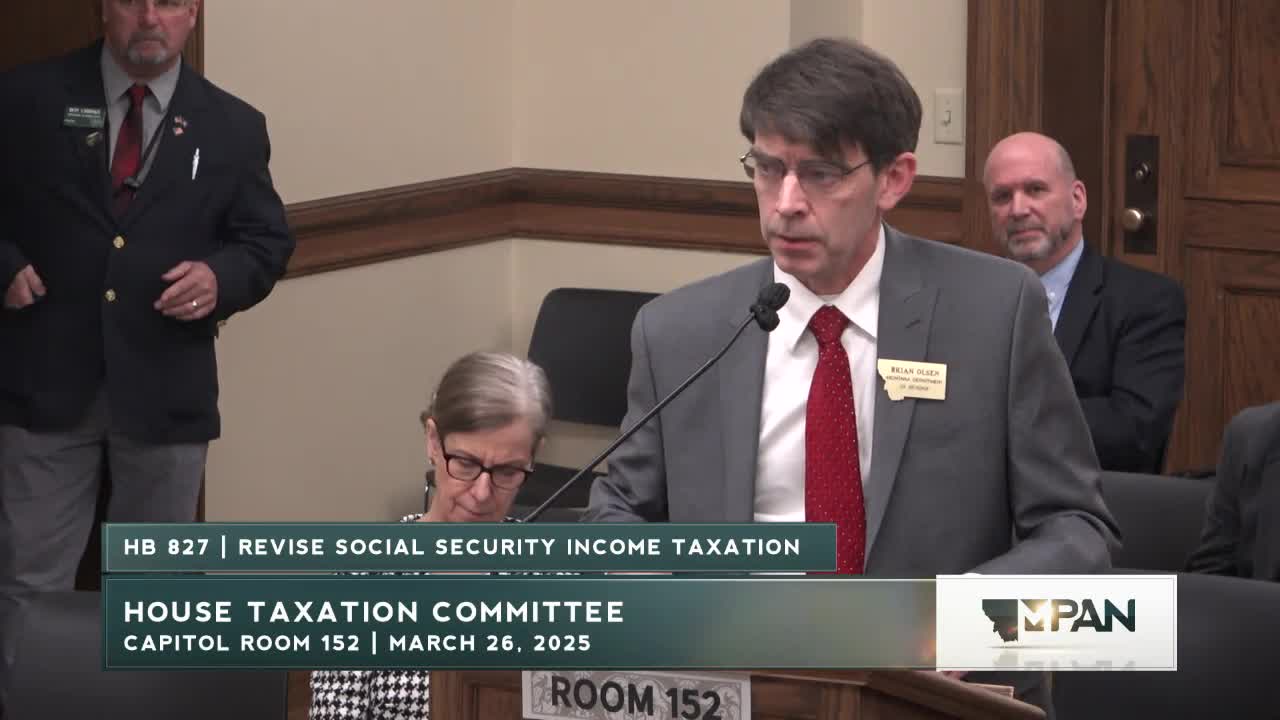Montana House Committee debates Social Security taxation and bill adjustments
March 26, 2025 | 2025 Legislature MT, Montana
This article was created by AI summarizing key points discussed. AI makes mistakes, so for full details and context, please refer to the video of the full meeting. Please report any errors so we can fix them. Report an error »

In a recent meeting of the Montana House Taxation Committee, lawmakers engaged in a detailed discussion about proposed changes to the taxation of Social Security benefits. The atmosphere was charged with a sense of urgency as committee members sought to clarify the implications of House Bill 827, which aims to adjust how Social Security income is taxed at the state level.
The bill proposes to increase the amount of Social Security income that is exempt from state taxation, a move that supporters argue would align Montana with many other states that do not tax these benefits at all. Representative Brewster highlighted that under current law, a portion of Social Security is included in taxable income, with thresholds set at $65,000 for married couples filing jointly, where 50% of benefits become taxable, and $77,000, where this rises to 85%. The proposed changes would effectively lower the taxable portion for Montanans, providing much-needed relief to seniors.
As the discussion unfolded, committee members requested visual aids to better understand the proposed changes. Representative Konauer asked for charts illustrating how different income levels would interact with the new tax structure, emphasizing the need for clarity in understanding the bill's impact. Mr. Olsen, a key figure in the discussion, assured the committee that he would provide these examples to facilitate a deeper understanding.
The conversation also touched on the relationship between state and federal tax laws, with Representative Rivas seeking clarification on how Montana's tax treatment of Social Security aligns with federal regulations. Mr. Olsen explained that while federal law provides a partial exemption, Montana's current law mirrors this, and the proposed bill would create a deviation that benefits state residents.
As the meeting drew to a close, Representative Brewster urged the committee to support the bill, framing it as a necessary step to enhance financial security for seniors in Montana. He emphasized that the fiscal implications, while significant, are outweighed by the potential benefits to the state's elderly population.
The committee's discussions reflect a growing recognition of the need to adapt tax policies to better support vulnerable populations, particularly as the state grapples with the challenges of an aging demographic. With further executive actions on the horizon, the committee is poised to continue its work on tax reform, aiming to strike a balance between fiscal responsibility and the welfare of its citizens.
The bill proposes to increase the amount of Social Security income that is exempt from state taxation, a move that supporters argue would align Montana with many other states that do not tax these benefits at all. Representative Brewster highlighted that under current law, a portion of Social Security is included in taxable income, with thresholds set at $65,000 for married couples filing jointly, where 50% of benefits become taxable, and $77,000, where this rises to 85%. The proposed changes would effectively lower the taxable portion for Montanans, providing much-needed relief to seniors.
As the discussion unfolded, committee members requested visual aids to better understand the proposed changes. Representative Konauer asked for charts illustrating how different income levels would interact with the new tax structure, emphasizing the need for clarity in understanding the bill's impact. Mr. Olsen, a key figure in the discussion, assured the committee that he would provide these examples to facilitate a deeper understanding.
The conversation also touched on the relationship between state and federal tax laws, with Representative Rivas seeking clarification on how Montana's tax treatment of Social Security aligns with federal regulations. Mr. Olsen explained that while federal law provides a partial exemption, Montana's current law mirrors this, and the proposed bill would create a deviation that benefits state residents.
As the meeting drew to a close, Representative Brewster urged the committee to support the bill, framing it as a necessary step to enhance financial security for seniors in Montana. He emphasized that the fiscal implications, while significant, are outweighed by the potential benefits to the state's elderly population.
The committee's discussions reflect a growing recognition of the need to adapt tax policies to better support vulnerable populations, particularly as the state grapples with the challenges of an aging demographic. With further executive actions on the horizon, the committee is poised to continue its work on tax reform, aiming to strike a balance between fiscal responsibility and the welfare of its citizens.
View full meeting
This article is based on a recent meeting—watch the full video and explore the complete transcript for deeper insights into the discussion.
View full meeting
